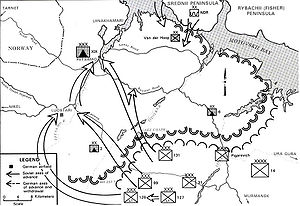Petsamo–Kirkenes offensive
This article includes a list of references, related reading, or external links, but its sources remain unclear because it lacks inline citations. (April 2009) |
| Petsamo-Kirkenes Offensive | |||||||
|---|---|---|---|---|---|---|---|
| Part of World War II | |||||||
 Soviet landing party heading for Kirkenes, Norway. | |||||||
| |||||||
| Belligerents | |||||||
|
|
| ||||||
| Commanders and leaders | |||||||
| K.A. Meretskov | Lothar Rendulic | ||||||
| Strength | |||||||
|
14th Army 96,000 men, 110 tanks, 2,100 guns |
20th Mountain Army ca. 56,000 men, 145 guns | ||||||
| Casualties and losses | |||||||
| 18,435 | unknown | ||||||

The Petsamo–Kirkenes Offensive was mounted by the Red Army against the Wehrmacht in 1944 in northern Finland and Norway. The offensive defeated the Wehrmacht's forces in the Arctic, driving them back into Norway, and was called the "Tenth Shock" by Stalin. It later liberated the northern part of Norway from German occupation and seized the nickel mines of Pechenga/Petsamo.
Situation
Following the failure of the Wehrmacht’s Operation Silver Fox in summer 1941, the frontline in the Arctic had seen little change. The environmental and supply conditions made it difficult, if not impossible, to undertake major military operations, and as far as land warfare was concerned, the Arctic had become a back-water. Sizable German forces were kept in the sector to protect the Finnish nickel mines of Petsamo, which produced a metal that was of high importance to German armour plate fabrication, and to protect the coast of northern Norway against an Allied landing operation.
Following the armistice between the Soviet Union and Finland on 4 September 1944, the Finnish government agreed to remove the remaining German forces from its territory by 15 September. During the retreat operations of the German 20th Mountain Army called Operation Birke, a decision was taken by the German Armed Forces Command to withdraw completely from northern Norway and Finland in Operation Nordlicht. During the preparations for this retreat operation, the Karelian Front went over to the offensive.
The preparations
Following the highly successful offensive operations along the whole of the frontline, the Stavka decided to move against the German forces in the Arctic in late 1944. The operation was to be undertaken jointly by Karelian Front under the command of K.A. Meretskov and Northern Fleet under Admiral Golovko. The main operations were to be conducted by 14th Army, which had been in the Arctic since the beginning of the war.
The offensive
The offensive can be divided into three phases: the breakthrough of the German position, the pursuit to Kirkenes, and the battle for Kirkenes including by the southward pursuit following it. During the offensive several amphibious landings were conducted by the naval infantry and army units.
Outcome
The offensive ended in a complete victory for the Red Army. The Soviet commander Meretskov was promoted to the rank of Marshal of the Soviet Union, and was given a prominent command during the Red Army's attack on Japanese held Manchuria, in August 1945.
The Petsamo–Kirkenes Operation is notable in that it was the last successful major offensive in an Arctic environment. It has been studied intensively in the Red Army for this reason.
Forces involved
Soviet
- 14th Army, total ca. 96,000 men
- 31st Rifle Corps
- 99th Rifle Corps
- 131st Rifle Corps
- Corps Pigarech
- 126th (light) Rifle Corps
- 127th (light Rifle Corps
German
- 20th Mountain Army
- XIX Mountain Corps, total ca. 56,000 men
- 2nd Mountain Division
- 6th Mountain Division
- Grenadier Regiment 388 attached
- 210th Infantry Division (a fortress division)
- Division Group van der Hoop (regiment strength)
- Bicycle Brigade Norway (regiment strength)
- XIX Mountain Corps, total ca. 56,000 men
Recommended reading
- James F. Gebhardt - The Petsamo-Kirkenes Operation
- Meretskov, K.A. ‘Im Dienste des Volkes’ (memoirs of the commander of Karelian Front)
- Khudalov ‘Am Rande des Kontinents’ (memoirs of the commander of 10th Guards Rifle Division)
